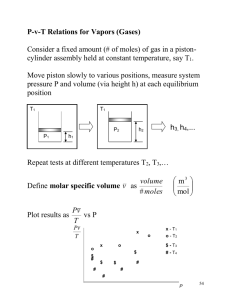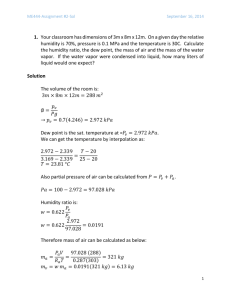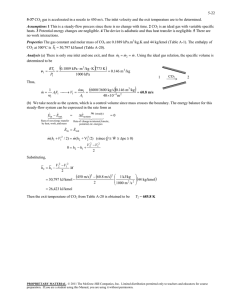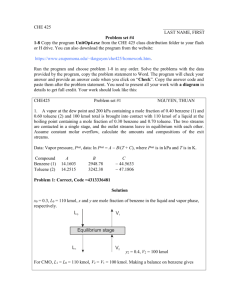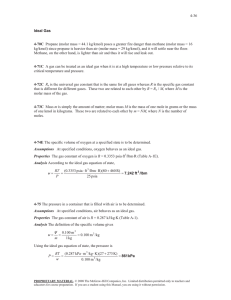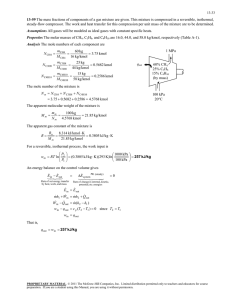Combustion
advertisement
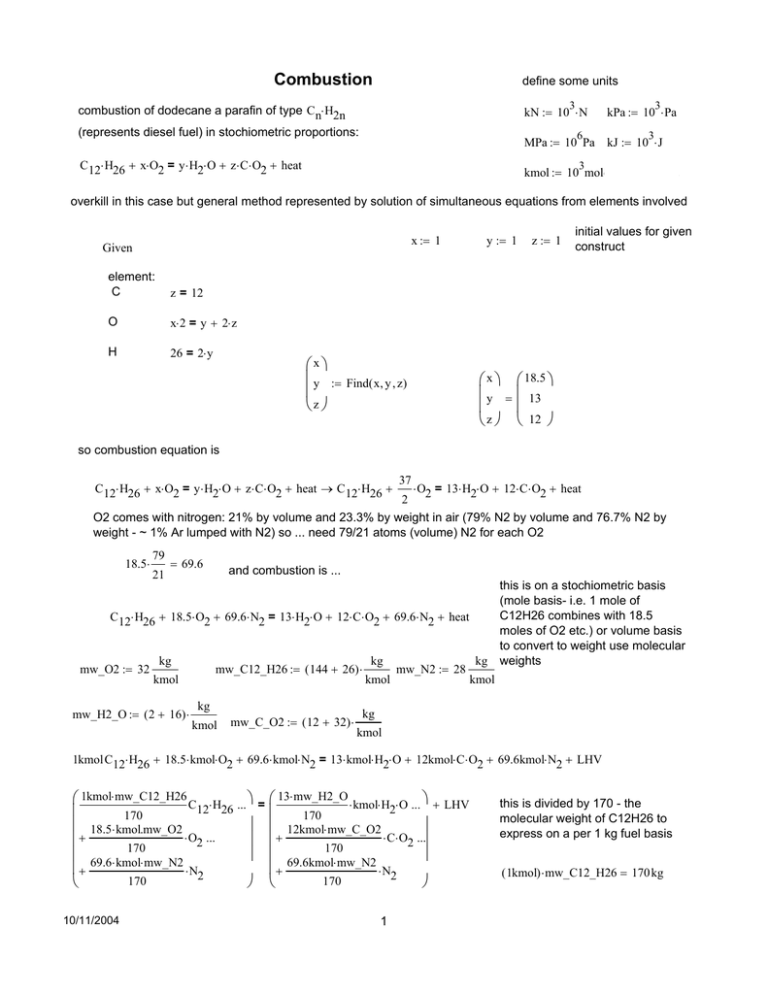
Combustion define some units 3 combustion of dodecane a parafin of type Cn⋅H2n (represents diesel fuel) in stochiometric proportions: kN := 10 ⋅N 6 MPa := 10 Pa C12⋅H26 + x⋅ O2 = y ⋅ H2⋅O + z⋅ C⋅O2+ heat 3 kPa := 10 ⋅Pa 3 kJ := 10 ⋅J 3 kmol := 10 molebar := 0.1MPa overkill in this case but general method represented by solution of simultaneous equations from elements involved x := 1 Given element: C z = 12 y := 1 z := 1 initial values for given construct O x⋅ 2 = y + 2⋅ z H 26 = 2⋅ y x y := Find( x, y , z) z x 18.5 y = 13 z 12 so combustion equation is 37 C12⋅H26 + x⋅ O2 = y ⋅ H2⋅O + z⋅C⋅O2 + heat → C12⋅H26 + ⋅O = 13⋅ H2⋅O + 12⋅ C⋅O2 + heat 2 2 O2 comes with nitrogen: 21% by volume and 23.3% by weight in air (79% N2 by volume and 76.7% N2 by weight - ~ 1% Ar lumped with N2) so ... need 79/21 atoms (volume) N2 for each O2 18.5⋅ 79 21 = 69.6 and combustion is ... C12⋅H26 + 18.5⋅ O2 + 69.6⋅ N2 = 13⋅ H2⋅O + 12⋅ C⋅O2 + 69.6⋅ N2 + heat mw_O2 := 32 kg mw_C12_H26 := (144 + 26)⋅ kmol mw_H2_O := (2 + 16)⋅ kg kmol mw_C_O2 := (12 + 32)⋅ kg kmol mw_N2 := 28 kg this is on a stochiometric basis (mole basis- i.e. 1 mole of C12H26 combines with 18.5 moles of O2 etc.) or volume basis to convert to weight use molecular weights kmol kg kmol 1kmolC12⋅H26 + 18.5⋅ kmol⋅O2 + 69.6⋅ kmol⋅N2 = 13⋅ kmol⋅H2⋅O + 12kmol⋅ C⋅O2 + 69.6kmol⋅ N2 + LHV 1kmol⋅ mw_C12_H26 C ⋅ H ... = 13⋅ mw_H2_O ⋅kmol⋅H ⋅O ... + LHV 12 26 2 170 170 18.5⋅kmol.mw_O2 12kmol⋅ mw_C_O2 ⋅O2 ... ⋅C⋅O2 ... + + 170 170 69.6⋅ kmol⋅mw_N2 69.6kmol ⋅ mw_N2 + ⋅N2 + ⋅N2 170 170 10/11/2004 1 this is divided by 170 - the molecular weight of C12H26 to express on a per 1 kg fuel basis (1kmol) ⋅ mw_C12_H26 = 170 kg for symbolic calculation result is ... combustion of C12H26 by weight ... 1kg⋅ C12⋅ H26 + 3.48⋅ kg⋅ O2 + 11.46⋅ kg⋅ N2 = 1.38⋅ kg⋅ H2⋅O + 3.11⋅ k ⋅C⋅ O2 + 11.46⋅ kg⋅ N2 + heat weight of air : weight of fuel = air-fuel ratio air_fuel_ratio := 3.48 + 11.46 air_fuel_ratio = 14.94 In order to insure complete combustion,air is usually supplied in excess, see example below. Products would include air i.e. O2 and N2 to analyze combustion process use first law ... steady state, steady flow process ... d Qc_v + dt ∑ n 2 Vi m_doti ⋅ hi + + g⋅ zi = n 2 work, KE and PE = 0 .. conservation of mass ... Q_dotc_v m_dotf = m_dot = flow_rate (5.46) 2 Ve d m_dote ⋅ he + + g⋅ ze + Wc_v n 2 dt ∑ n Q_dotc_v + m_dotf⋅ hf + m_dota⋅ ha = m_dotp⋅ hp (5.47) p = products m_dotp = m_dotf + m_dota m_dota m_dota m_dota ⋅hp − hf + ⋅ ha = 1 + ⋅ hp − hf + ⋅h m_dotf m_dotf a m_dotf m_dotf m_dotp or per unit mass ... Qc_v = HP − HR R = reactants To quantitatively calculate this equation the basic approach would include accounting for the enthalpy of formation of each of the entities in the process. To avoid repeatedly accounting for the enthalpy of formation of various fuels a calculation (measurement) is done at a standard condition and then specific processes need only account for the deviation from this standard. The standard chosen was 25 deg C and atmospheric pressure (100 kPa) designated the zero (0) subscript. e.g. the enthalpy of formation of C -> CO2 such that 1 kmol C combines with 1 kmol O2 to yield 1 kmol CO2 gives off 393,522 kJ/kmol. This measurement for fuels is accomplished and the net result is tabulated as the heating value. If the H2O in the products is liquid it is the higher heating value (HHV), if the H2) is vapor - the heating value is the lower heating vaue (LHV). The difference is due to the heat of vaporization being extracted as heat. negative as heating value usually expressed as positive negative Q in first law indicates heat given off Qc_v_0 = HP0 − HR0 = −heating_value some typical values ... 10/11/2004 . . distillate heavy_bunker dodecane = diesel octane = gasoline HHV LHV sp_gr kJ kJ kg kg 45900 43000 0.825 42900 40600 1.014 47470 44109 _ 47893 44425 2 . _ from Prof. Carmichael's notes and Table 12.3 in Van Wylen and Sonntag. dodecane and octane are in liquid form. Vapor form has slightly higher value same concept as HHV vs LHV that is ... kJ Qc_v_0_octane = HP0 − HR0 = −heating_value = −47893 kg fuel as liquid, water in preoduct as liquid this enables us to write ... ( ) ( ) ( ) Qc_v = HP − HR = HP − HP0 − HR − HR0 + HP0 − HR0 = HP − HP0 − HR − HR0 − heating_value or ... writing for boiler, ... ( ) −Qc_v = −QB = HR − HR0 − HP − HP0 + heating_value QB on unit mass basis or on a specific enthalpy basis ... − m_dota m_dota = −QB = hf − hf0 + ⋅ ha − ha0 − 1 + ⋅ hp − hp0 + heating_value m_dotf m_dotf m_dotf Q_dotc_v ( ) ( ) so ... in calculation of boiler process, need only to look up heating value for fuel - appropriate to its state as gas or liquid and water product state as gas or liguid (HHV or LHV) then "correct" heat for deviation from standard state using gas tables or other estimates. With this result can calculate boiler efficiency ... m_dota m_air_dot HV + hf − hf0 + ⋅ ha − ha0 − 1 + ⋅ h − hp0 Q_dotc_v −QB m_dotf m_fuel_dot p ηB = − = = m_dotf⋅HHV HHV HHV ( ) ( ) ( ) if for example, the fuel and air entering the boiler are at standard conditions (25 deg C, atmospheric pressure) and the H2O in the exhaust is vapor, the boiler efficiency becomes ... ha − ha0 = 0 m_air_dot LHV − 1 + ⋅ ( h − hp0) m_fuel_dot p ηB = HHV hf − hf0 = 0 As an example, let's consider the effect of exhaust (stack) temperature on efficiency ... the calculations are straight-forward but extensive. We will specify combustion with 15 % excess air of dodecane ... The calculation of enthelpy of the products is the challenge. Either it can be done by "unlumping" the participants or forming a weighted average of the product enthalpies. 10/11/2004 3 example ... combustion of dodecane with 15 % excess air, fuel and air entering at standard conditions, H2O exhaust as vapor, estimate efficiency of the combustion process with exhaust temperature of 120, 230, and 340 deg C. An additional calculation at 226.85 deg C will be done to check the calculations. Assume also 1.5 % heat loss to environment. from above ..result is ... combustion of C12H26 by weight ... adjusted for 15 % excess air ... and using the LHV ( ) 1kg⋅C12⋅H26 + 3.48⋅ kg⋅O2 + 11.46⋅ kg⋅N2 ⋅1.15 = 1.38⋅ kg⋅H2⋅O + 3.11⋅ kg⋅C⋅O2 + 11.46⋅ kg ⋅N2 ... + LHV + 3.48⋅ kg⋅ O + 11.46⋅ kg⋅N ⋅0.15 2 2) ( which is same as ... athough we will use elemental expression for enthalpy calculation - probably could use air parameters C12⋅H26 + (3.48 + 11.46) ⋅ 1.15⋅air = 1.38⋅ H2⋅O + 3.1⋅ C⋅ O2 + 11.46⋅ N2 + (3.48 + 11.46) ⋅ 0.15⋅air + LHV weighted average statement .... where m_xx is mass of the entity m_H2_O⋅ hH ⋅O − hH ⋅O⋅0 + m_C_O2⋅ hC⋅ O − hC⋅ O ⋅0 ... 2 2 2 2 + m_N2⋅ hN − hN ⋅0 + (m_O2 + m_N2) ⋅ 0.15⋅ ( hair − hair⋅ 0) 2 2 hp − hp0 = m_H2_O + m_C_O2 + m_N2 + (m_O2 + m_N2) ⋅ 0.15 to calculate enthalpies at non-standard conditions use constant-pressure specific heats from Table A.9 of Van Wylen and Sonntag ... O2 Cpo_O2( θ ) := 37.432 + 0.020102⋅θ C_O2 Cpo_C_O2( θ) := −3.7357 + 30.529⋅θ N2 Cpo_N2( θ ) := 39.060 − 512.79⋅θ H2_O Cpo_H2_0( θ ) := 143.05 − 183.54⋅θ 120 230 + 273.15 ⋅K θT := T T := 340 100K 500 − 273.15 10/11/2004 1.5 − 178.57⋅θ 0.5 − 1.5 + 236.88⋅θ − 4.1034⋅θ + 0.024198⋅θ + 1072.7⋅θ 0.25 − 1.5 −2 + 82.751⋅θ 3.93 5.03 θT = 6.13 5 4 − 820.40⋅θ 0.5 −2 2 −3 − 3.6989⋅θ kJ θ = T 100 kmol⋅ K kJ kmol⋅ K given in kJ/kmole*K so divide by molecular weight to get kJ/kg*K kJ kmol⋅ K kJ kmol⋅ K 393.15 503.15 T= K 613.15 500 T0 := (25 + 273.15)K 500 − 273.15 = 226.85 integrate dh = Cp⋅dT with variable change to θ. hH_2OT = h −h H2⋅O H2⋅O⋅0 i := 0 .. 3 H2_O Ti ⌠ K⋅ 100 kJ Cpo_H2_0( θ ) ⋅100 dθ kmol ⌡ T0 K⋅ 100 hH_2OT := i mw_H2_O C_O2 Ti ⌠ K⋅ 100 kJ Cpo_C_O2( θ ) ⋅100 dθ kmol ⌡ T0 K⋅ 100 hC_O2T := i mw_C_O2 178.81 390.4 kJ hH_2OT = 609.19 kg 384.25 84.39 191.77 kJ hC_O2T = 307.3 kg 188.57 N2 Ti ⌠ kJ K⋅ 100 Cpo_N2( θ ) ⋅100 dθ kmol ⌡ T0 K⋅ 100 hN2T := i mw_N2 99.01 214.22 kJ hN2T = 331.66 kg 210.9 O2 Ti ⌠ kJ K⋅ 100 Cpo_O2( θ ) ⋅100 dθ kmol ⌡ T0 K⋅ 100 hO2T := i mw_O2 10/11/2004 5 88.02 193.2 kJ hO2T = 302.34 kg 190.13 etc.... these data could also have been obtained from gas tables. as a check the values for the reference temperature were obtained fromTable A.11 of VW &S - taken from the gas tables kJ hH_2OT ⋅mw_H2_O = 6916.45 3 kmol 6920 in table A.11 kJ hC_O2T ⋅mw_C_O2 = 8297.06 3 kmol 8314 in table A.11 kJ hN2T ⋅mw_N2 = 5905.1 3 kmol 5912 in table A.11 kJ hO2T ⋅mw_O2 = 6084.08 3 kmol 6088 in table A.11 now calculate weighted average ... separating air into N2 and O2 m_H2_O := 1.38 hprod := m_C_O2 := 3.1 m_N2 := 11.46⋅ 1.15 h.prod is weighted average of products m_O2 := 3.48⋅ 0.15 102.26 223.16 kJ hprod = 347.73 kg 219.65 hH_2OT⋅m_H2_O + hC_O2T⋅m_C_O2 + hN2T⋅m_N2 + hO2T⋅m_O2 m_H2_O + m_C_O2 + m_N2 + m_O2 LHV := 44109 LHV − η B = HHV := 47470 kg kJ kg 1 + m_air_dot ⋅ h − h ( p0) m_fuel_dot p HHV air_fuel_ratio = in this case η B := kJ m_air_dot m_fuel_dot in stochiometric combustion = 14.94 air_fuel_ratio := 14.94⋅ 1.15 LHV − (1 + air_fuel_ratio) ⋅ hprod HHV ⋅0.985 if we had just calculated the products individually, instead of the weighted average ... 0.877 0.831 ηB = 0.784 0.832 heat loss accounted for by reucing net heat from combustion * 0.985 C12⋅H26 + (3.48 + 11.46) ⋅ 1.15⋅air = 1.38⋅ H2⋅O + 3.1⋅ C⋅O2 + 11.46⋅N2 + (3.48 + 11.46) ⋅ 0.15⋅air + LHV η B := ( LHV − 1.38⋅ hH_2OT + 3.1⋅ hC_O2T + 11.46⋅ 1.15⋅ hN2T + 3.48⋅ 0.15⋅hO2T 10/11/2004 HHV 6 ) ⋅0.985 0.877 0.831 ηB = 0.784 0.832 effect of excess air air_fuel_ratio = m_air_dot in stochiometric combustion = 14.94 m_fuel_dot 0.1 exc_air := 0.15 0.25 m_H2_O := 1.38 j := 0 .. 2 m_C_O2 := 3.1 ( m_N2 := 11.46⋅ 1 + exc_air j ) m_O2 := 3.48⋅ exc_air j j hH_2OT ⋅m_H2_O + hC_O2T ⋅m_C_O2 + hN2T ⋅m_N2 + hO2T ⋅m_O2 j j i i i i hprod := i, j m_H2_O + m_C_O2 + m_N2 + m_O2 j j 102.51 223.75 hprod = 348.71 220.23 in this case ηB i, j ηB i,0 := ( ) LHV − 1 + air_fuel_ratio ⋅hprod j i, j HHV 223.16 222.11 kJ 347.73 345.99 kg 219.65 218.62 heat loss accounted for by reucing net heat from combustion * 0.985 air_fuel_ratio := 14.94⋅ (1 + exc_air) j 102.26 101.82 j 0.878 0.834 ⋅0.985 ηB = 0.789 0.836 0.877 0.874 0.831 0.825 0.784 0.774 0.832 0.826 0.85 ηB i,1 ηB i,2 0.8 0.75 120 140 160 180 200 220 240 Ti−273.15 10/11/2004 j 7 260 280 300 320 340


